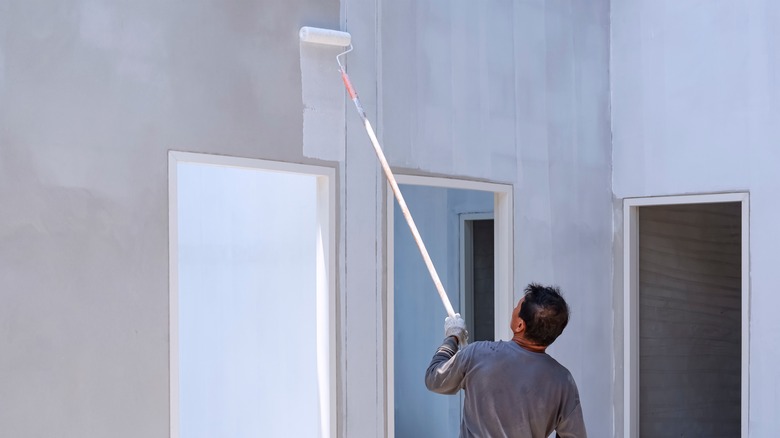The Hidden Downsides Of Using Paint And Primer In One
When you are preparing to give a room a facelift, applying a fresh coat of paint is a popular and effective choice. However, it also can be a lot of work, from moving furniture to laying out a drop cloth to adding masking tape to the trim and baseboards. Consequently, many people are looking for a shortcut that helps them do the work faster. You may have a temptation to make use of a paint and primer in one product that claims to save you a step by putting the primer on the walls at the same time you are applying the final color of paint that you want to use. However, this time-saving product doesn't always work as intended, as it has some downsides that you should understand before deciding to use it.
For starters, it struggles to deliver the desired coverage on certain surfaces. One of the most important tips for using a paint and primer combination is that you need to use it in the proper location. It typically works best on walls that already have a coat of paint on them and that do not have stains that could bleed through. Because of coverage issues with paint and primer in one on certain surfaces, you could find yourself needing to go over the space multiple times to hide imperfections and stains. Having to apply multiple coats is a major drawback, as you'll end up spending more time than expected on the work.
Why a paint and primer in one product isn't as good as it sounds
You may believe that the combination product will let you finish the job with half the cost of using separate coats of primer and paint. However, because you often need a second or third coat to help with stains that bleed through, and because there's a far higher cost for using the all-in-one product per gallon, it's probable that you will not end up saving money by using it versus separate paint and primer products on most surfaces. The all-in-one option really only saves time and money if you have the perfect conditions and surface before starting.
Another major hidden drawback to the paint and primer in one product is that there are no requirements or oversight for creating the formula. Consequently, some manufacturers emphasize having more primer in the mix, while others emphasize more finish paint. You may even find some all-in-one products that contain no actual primer. These manufacturers simply thicken a gallon of finishing paint, hoping that it will provide results that help with coverage. It ends up being more of a marketing slogan than an actual product that contains what it promises. Some manufacturers have even tried to take advantage of the marketing attention by simply rebranding their older products and now calling them paint and primer in one without actually changing the formula. You just have no guarantees with formulas or product concentrations with the all-in-one products.
Why some surfaces need a separate primer first
One reason to consider using a paint and primer in one is because you know the importance of applying a primer to certain surfaces. If you attempt to paint without before using a primer on surfaces that have a porous makeup, like new drywall, skim-coated drywall, or concrete, you should use a primer. Glossy surfaces like metal or plastic, or surfaces that contain a glossy type of paint already, also can use a primer to help the new coat of paint adhere better, resulting in a long-lasting job.
Ultimately, because primer has such a specific job — preparing the surface to accept the new coat of paint — the all-in-one product simply doesn't have the proper formula to allow it to work in the exact same way. The primer alone focuses on serving as an adhesive undercoat, which means that it needs to have a higher concentration of resins in it than what the final coat product will have. These resins allow it to have some of the same properties as a liquid "glue" while allowing it to deliver a smooth covering for the next coat.
The all-in-one product can't contain as many resins because it needs to contain more pigments that deliver the color that you want in your final coat, more like what you'd find with a gallon of finishing paint. Simply put, by trying to fulfill both needs, the all-in-one product can't match the benefits of either original product.


